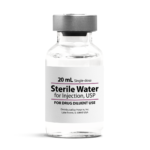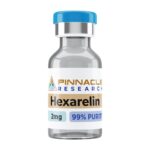About GHRP-6
Researchers and scientists are constantly looking for synthetic compounds that can enhance our health. While the body produces various enzymes and catalysts to facilitate bodily functions, sometimes, we require artificial compounds to enhance the functionality of these bodily functions. GHRP-6 is one of the artificial peptides intended to enhance somebody’s cells’ functionality.
What Is GHRP-6?
GHRP-6 is a research compound that effectively stimulates the natural GRH (growth release hormone) found in the anterior pituitary. It is also a growth hormone receptor agonist (ghrelin) and one of the few effective artificial ghrelin analogs. Studies involving the peptide have revealed the compound has positive effects on the following:
- Memory formation
- Heart muscle cells
- Scar formation
- Neurons in Parkinson’s disease
- Sex motivation
The research compound is sublingual and orally active and highly to moderately selective.
The GHRP-6 Chemical Structure
- Sequence: His-D-Trp-Ala-Trp-D-Phe-Lys
- Molecular Formula: C46H56N12O6
- Molecular Weight: 873.032 g/mol
- CAS Number: 87616-84-0
GHRP-6 Research and Effects
Improves Memory
Researchers have been actively investigating the role of physical activities in memory formation and learning. Despite the connection being elusive, many refreshers are convinced that physical activity enhances cognition and learning, mainly when the workout is done after a learning experience. Researchers initially assumed that cognition benefitted from exercise because of improved blood flow, while some have vaguely linked the connection to growth hormone (GH). The latter was later confirmed by a research study involving rodents, which showed that the growth hormone (GH) is essential in memory formation. The studies revealed that GHRP-6 could enhance the solidification of newly formed and short-term memories and the conversion of short-term memories into long-term ones and storing them. Additional studies have revealed strong evidence supporting the connection between ghrelin/GHRP-6 and spatial learning tasks.
Protects Brain Tissue
In a research study, the stroke animal models were used in investigating the GHRP-6’s ability to protect cells in the nervous systems and neurons. The synthetic peptide protects the cells in the central nervous system from side effects caused by poor blood supply. It was discovered that the GHRP-6 offered protection to the brain cells in the incident of a stroke. If the peptide is administered promptly, it also rescues memory deficits after a stroke. Ghrelin and its synthetic analogs inhibit programmed cell death (apoptosis), reduce brain inflammation, and protect the neurons after a stroke.
Protects Parkinson’s Neurons
A 2018 research study revealed that the GHRP-6 could protect brain tissue; ghrelin receptors were discovered at the substantia nigra. The substantia nigra is a section of the brain affected by Parkinson’s disease. Through genetic links, most patients with Parkinson’s disease tend to have low levels of the ghrelin receptors on the substantia nigra’s neurons. Rats with the same condition exhibited Parkinson’s symptoms after administering an antagonist. Therefore agonists like GHRP-6 can be used in treating Parkinson’s disease.
Reduces Scarring and Improves Skin Appearance
When GHRP-6 reduces programmed cell death, it enhances the survival of many cells in the body. Additionally, it interacts with the CD36 receptor when administered, which promotes blood vessel growth, especially during healing. Research studies revealed that the mentioned GHRP-6 properties made the compound highly useful in wound healing. The research compound enhanced wound closure and improved the creation of extracellular matrix proteins. Additionally, it helped in reducing scar tissue appearance by interfering with the scar formation process. Other studies have confirmed that the peptide can prevent the development of hypertrophic scar (like keloids). The GHRP-6 prevents improper extracellular matrix protein depositions, thus eliminating the formation of hypertrophic scars, which is essential to people suffering from an aberrant healing process.
Reduced Heart Problems
Scientists carried out a research study on heart attack porcine models and discovered that the GHRP-6 prevented oxidant cytotoxicity. Prevention of oxidant cytotoxicity means synthetic peptide protects the body’s heart cells from destruction by free radicals. There is great hope that more studies findings will help develop medication to protect the heart cells after a heart attack or stroke. The medication will reduce deaths and enhance faster improvement after a heart attack.
Altering Sex Mood and Motivation
Research studies on male rats have linked ghrelin receptors found in the central nervous system with sexual motivation and behavior. High levels of ghrelin trigger enhanced sexual motivation. Further studies were done involving the synthetic peptide and a modified version of the GHRP-6 designed explicitly for the antagonization of the ghrelin receptor. These studies revealed that the ghrelin receptors in the brain facilitated the modulation of reward-seeking behavior and sexual behavior. There is also scientific evidence that suggests a connection between ghrelin and mood. During a research study on mice, the GHRP-6 and ghrelin receptor agonists achieved decreased depression while improving the brain’s functionality that involved stress management.
The GHRP-6 is a popular peptide that can potentially be a novel treatment option for many illnesses ranging from improving memory to helping patients with Parkinson’s disease. During the research studies, when the synthetic peptide was administered, it had manageable side effects, excellent subcutaneous bioavailability, and low oral. However, the peptide has only been used in rodents and not in human beings; hence the dosage for rats shouldn’t be used by humans. Additionally, the research compound is still in the research process and not available for human use.
If you are a licensed researcher, you can buy the GHRP-6 and learn more about the peptide, but if you don’t have a license, you can still learn more about the peptide by checking our frequent updates on the drug.




